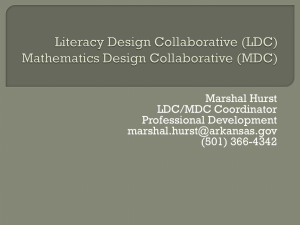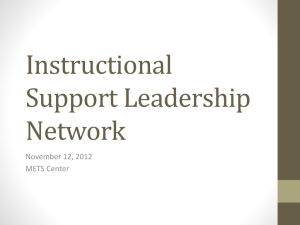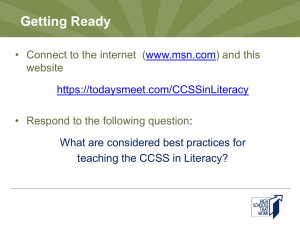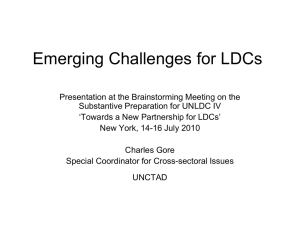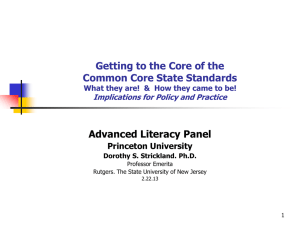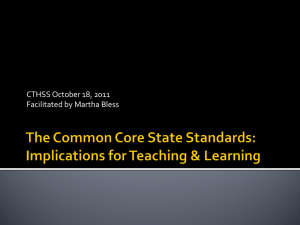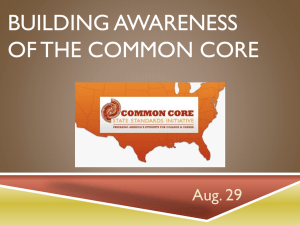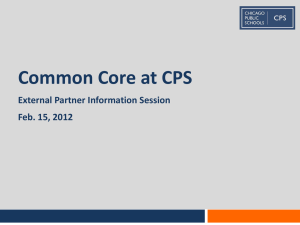ACE Common Core Presentation
advertisement
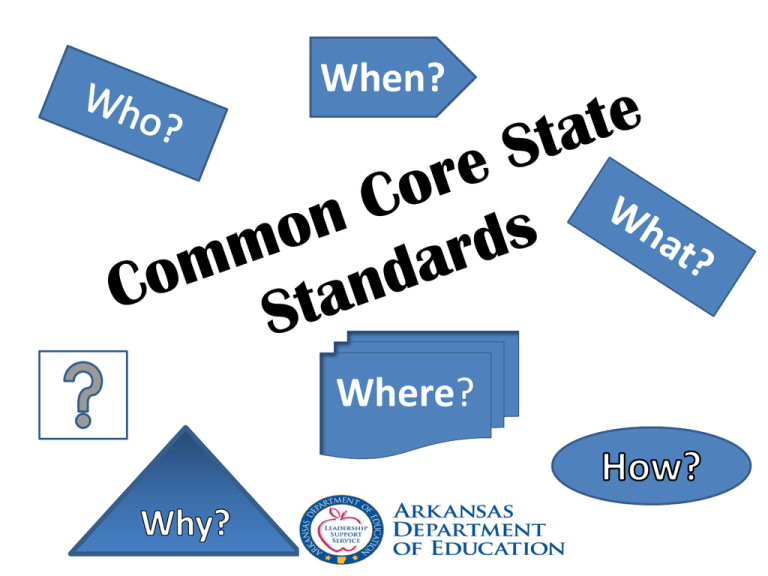
When? Where? CCSS – where are we? Monday, July 23 When? & Where? Grades K-2: 20112012 Grades 3-8: 2012 2013 • Grades 9-12: 20132014 • PARCC Assessment 2014-2015 All Districts in AR Summer 2012 Curriculum and Professional Development units: • Workshops – – close reading and disciplinary reading, – writing arguments, – technology in the classroom, and – resources Institutes and Leadership series www.Ideas.aetn.org/commoncore/ Institutes available: • Strategic plan • Assessment • Lesson planning for Formative Assessment • Learning Progressions in ELA and math Leadership series Summit 1 • Facilitating Learning for Teachers and Students • Student-Centered Coaching and Capacity Building for Instructional Leaders • Literacy Design Collaborative (LDC) and Mathematics Design Collaborative (MDC) Summit 2 • Connecting Common Core and Community for the Whole Child: A Community Conversation Subject Areas • English Language Arts 1 - Disciplinary (Content) Literacy Overview • English Language Arts 2 - Close Reading of Complex Text • Overview of the Common Core State Standards for English Language Arts & Literacy in History/Social Studies, Science, and Technical Subjects • Role of content teacher in literacy practices • Examining classroom practices • Defining text complexity and the overarching role it plays in The Common Core State Standards for English Language Arts & Literacy in History/Social Studies, Science, and Technical Subjects • Close reading – the demands of complex text on the reader • High yield questioning strategies for student use in comprehending complex text Where to locate CCSS information • CCSS site http://www.corestand ards.org/ • PARCC Model Content Frameworks http://www.parcconlin e.org/parcc-contentframeworks • Student Achievement Partners site http://www.achieveth ecore.org/ • Publisher’s Criteria grades K-2 http://www.corestand ards.org/assets/Publish ers_Criteria_for_K2.pdf • Publisher’s Criteria grades 3-12 http://www.corestand ards.org/assets/Publish ers_Criteria_for_312.pdf Where to locate CCSS information • AETN IDEAS site http://ideas.aetn.org/c ommoncore/strategicplan • ADE CCSS Microsite http://www.commonc orearkansas.org/ • ADE CCSS wiki http://ccssarkansas.pb works.com To Do this year from Sandra Alberti: • Teachers must be aware of CCSS and understand the big shifts • Identify, evaluate, and develop text dependent and text specific questions • Teachers must begin reviewing existing materials to develop these text dependent questions CCSS Create New Challenges Unlike mathematics, secondary literacy is not a discipline. It is “homeless” in that it belongs to everyone and no one. Literacy is used in all secondary classrooms, but it is not taught in a systematic way. How can teachers use LDC modules to meet this challenge? LDC/MDC • Designed to make literacy (math) instruction the foundation of the core subjects • Teachers leading the development • Supported by Bill & Melinda Gates Foundation • LDC/MDC is the high school training for Common Core in AR • http://www.literacydesigncollaborative.org/ AR LDC/MDC Project 2011-12; Pilot – 5 districts, 8 schools • • • • • PCSSD – Sylvan Hills, No. Pulaski Co. Fort Smith – Northside & Southside Rogers – Rogers High & Rogers Heritage Cossatot River – Wickes High Monticello – Monticello High AR LDC Project the beginning 2011-12 • 42 teachers were trained in LDC cohort 1 • 26 teachers were trained in MDC cohort 1 What’s next for 2012-13? • 2012-13 – about 50 high schools from districts across the state have joined the LDC/MDC project • 2 initial training sessions for teacher facilitators –July 18-20 –July 24-26 Essential Elements for a successful program: • Instructional leadership – who should be on team? – Literacy – ELA, Science, Social Studies, & Career ed. teachers – Math – algebra & geometry teachers – Leadership & support – principal, asst. principal, instructional facilitators, district office Essential Elements : • • • • • • • Time involved Regional training - July 3 days; 6 days followup On-site visits – 8 for the school year Conference calls (8) Webinars (8) Planning time is essential Classroom implementation PLC Capacity building The LDC Framework & Tasks The tasks students engage are at the center! Courses Modules Tasks • New courses • Existing courses • • • • Task Skills Instruction Results • Prompt • Rubric • Scoring exemplars LDC – Essential Vocabulary • Module – provides an instructional plan for the teaching task (2-4 week plan) – Defines literacy skills – Addresses a content area theme or issue – Complete module includes: • Sample student work that meets rubric • Other supports for teachers and students LDC – Essential Vocabulary • Template task – includes fill in blank sentence shell (built off CCSS in reading and writing) that can be used to create assignments or assessments Template Tasks beginning point for the LDC strategy. All LDC tasks require students to: Read, analyze, and comprehend texts as specified by the common core Write products as specified by the common core (focusing on argumentation, informational/explanatory, and narrative) Apply common core literacy standards to content (ELA, social studies, and/or science) The tasks are designed to ensure that students receive literacy and content instruction in rigorous academic reading and writing tasks that prepare them for success in college by the end of their high school career. LDC – Essential Vocabulary • Teaching task = completed template task – created when teacher fills in their reading and writing assignments – 2 basic types: “essential question” and “after reading” – content/issue to be addressed, specifies text and identifies product to be produced LDC – Essential Vocabulary • Skill list – specific skills students need to have or be taught – in order to successfully complete teaching task • Mini-tasks – small, scorable assignments that address each skill on skills list • Instructional ladder – the “lesson plan” pulls together skills, mini-tasks, instructional strategies More LDC/MDC information is available at: http://ideas.aetn.org/commoncore/l eadership Leadership Series 3 – Literacy Design Collaborative (LDC) and Mathematics Design Collaborative (MDC) April 4, 2012 CCSS Define Literacy in Content Areas While the English language arts classroom has often been seen as the proper site for literacy instruction, this document acknowledges that the responsibility for teaching such skills must also extend to other content areas. http://www.corestandards.org Students Who are College and Career Ready: • demonstrate independence, • build content knowledge, • respond to demands of audience, task, purpose, and discipline, • comprehend and critique, • value evidence, • use technology and digital media, and • come to understand other perspectives and cultures. CCSS, page 7 Questions to think about now • How do we help students think in social studies/science/technical subjects? • What types of critical texts are students expected to learn and maneuver? • What types of writing are expected? What CC Literacy Standards are NOT • … just having students read and write more • … assigning more vocabulary words to look up and write definitions for • … conducting basic literacy techniques to struggling readers during class time What CC Literacy Standards are NOT • … giving students Venn diagrams and sentence diagramming assignments in social studies • …assigning more “What did you do during …” essays What They Are • Modeling and scaffolding what reading in your subject area looks and sounds like • Teaching students what is important/vital information in your discipline What They Are • Using the text book as a starting place not the definitive source • Reading a wide variety of texts – Maps, charts, tables, graphs, photographs, pictures, cartoons, journals, letters, documents, artifacts SCAFFOLDING Definition - a temporary structure put up to allow you to work the text in a way that wouldn't be possible w/o the scaffold. • It is NOT a reading assignment, which treats kids as independent readers. Text Complexity Qualitative an attentive human reader Quantitative Reader and Task computer software Educators’ professional judgment is often best measured by The Big Shifts • Appropriate Text Complexity • Increased Reading of Informational Texts • Disciplinary Literacy • Close Reading • Text-dependent Questions • Academic Vocabulary--Tier 2 & Tier 3 words •Short & Sustained Research Projects •Argumentative Writing 34 Close Reading Requires: •Understanding your purpose in reading •Understanding the author’s purpose in writing •Seeing ideas in a text as being interconnected •Looking for and understanding systems of meaning •Engaging a text while reading •Getting beyond impressionist reading •Formulating questions and seeking answers to those questions while reading Disciplinary Reading Range and Content • Critical to building knowledge in content areas • Requires an appreciation of norms & conventions of each discipline • Necessitates an understanding of domainspecific words and phrases • Calls for an attention to precise details • Demands the capacity to evaluate intricate arguments, synthesize complex information , and follow detailed descriptions of events and concepts Comprehension Strategies All Good Readers Use Pre-reading • Review vocabulary • Make predictions • Review text features (brainstorm, predict, skim, assess prior knowledge) Comprehension Strategies All Good Readers Use While reading • Monitor for understanding; reread if needed; summarize • Draw a visual representation of the unfolding argument • Ask questions about the main ideas as they unfold; infer • Make note of unfamiliar words, concepts, ideas to research later Comprehension Strategies All Good Readers Use After reading: –Summarize and restate the text’s main points –Compare notes with other students –Discuss what you read –Reread, confirm predictions, reflect, question Writing & CC Literacy Standards What does that mean and look like in the content areas? Disciplinary Writing Range and Content • Key means of asserting and defending claims and showing what is known • Considers audience, task, and purpose • Uses technology strategically • Emphasizes writing arguments and informative/explanatory pieces Writing Standards 7, 8, and 9: Research to Build and Present Knowledge • • • • Research at all grade levels Use print and digital sources Evaluate sources Write without plagiarism Writing • Argument or Persuasive Writing With evidence from the text Most emphasized with CCSS • Informational/Explanatory Writing Tracy Tucker Tracy.tucker@arkansas.gov 501-682-1991 or Maggie Herrick Margaret.herrick@arkansas.gov 501-682-6584
